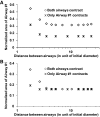Mechanical interactions between adjacent airways in the lung
- PMID: 24481963
- PMCID: PMC3949239
- DOI: 10.1152/japplphysiol.01180.2013
Mechanical interactions between adjacent airways in the lung
Abstract
The forces of mechanical interdependence between the airways and the parenchyma in the lung are powerful modulators of airways responsiveness. Little is known, however, about the extent to which adjacent airways affect each other's ability to narrow due to distortional forces generated within the intervening parenchyma. We developed a two-dimensional computational model of two airways embedded in parenchyma. The parenchyma itself was modeled in three ways: 1) as a network of hexagonally arranged springs, 2) as a network of triangularly arranged springs, and 3) as an elastic continuum. In all cases, we determined how the narrowing of one airway was affected when the other airway was relaxed vs. when it narrowed to the same extent as the first airway. For the continuum and triangular network models, interactions between airways were negligible unless the airways lay within about two relaxed diameters of each other, but even at this distance the interactions were small. By contrast, the hexagonal spring network model predicted that airway-airway interactions mediated by the parenchyma can be substantial for any degree of airway separation at intermediate values of airway contraction forces. Evidence to date suggests that the parenchyma may be better represented by the continuum model, which suggests that the parenchyma does not mediate significant interactions between narrowing airways.
Keywords: airway mechanics; finite element model; mechanical heterogeneity; parenchymal mechanics; spring network model.
Figures







Similar articles
-
Continuum vs. spring network models of airway-parenchymal interdependence.J Appl Physiol (1985). 2012 Jul;113(1):124-9. doi: 10.1152/japplphysiol.01578.2011. Epub 2012 Apr 12. J Appl Physiol (1985). 2012. PMID: 22500006 Free PMC article.
-
Airway-parenchymal interdependence in the lung slice.Respir Physiol Neurobiol. 2013 Jan 15;185(2):211-6. doi: 10.1016/j.resp.2012.10.015. Epub 2012 Nov 2. Respir Physiol Neurobiol. 2013. PMID: 23128069 Free PMC article.
-
Influence of parenchymal heterogeneity on airway-parenchymal interdependence.Respir Physiol Neurobiol. 2013 Aug 15;188(2):94-101. doi: 10.1016/j.resp.2013.06.005. Epub 2013 Jun 11. Respir Physiol Neurobiol. 2013. PMID: 23770309 Free PMC article.
-
Airway-parenchymal interdependence.Compr Physiol. 2012 Jul;2(3):1921-35. doi: 10.1002/cphy.c110039. Compr Physiol. 2012. PMID: 23723029 Free PMC article. Review.
-
The mechanics of the lung parenchyma and airway responsiveness to metacholine.Monaldi Arch Chest Dis. 2004 Oct-Dec;61(4):222-5. doi: 10.4081/monaldi.2004.685. Monaldi Arch Chest Dis. 2004. PMID: 15909612 Review.
Cited by
-
Resistance to alveolar shape change limits range of force propagation in lung parenchyma.Respir Physiol Neurobiol. 2015 Jun;211:22-8. doi: 10.1016/j.resp.2015.03.004. Epub 2015 Mar 23. Respir Physiol Neurobiol. 2015. PMID: 25812796 Free PMC article.
-
A Distribution-Moment Approximation for Coupled Dynamics of the Airway Wall and Airway Smooth Muscle.Biophys J. 2018 Jan 23;114(2):493-501. doi: 10.1016/j.bpj.2017.11.020. Biophys J. 2018. PMID: 29401446 Free PMC article.
-
Modeling the Progression of Epithelial Leak Caused by Overdistension.Cell Mol Bioeng. 2016 Mar;9(1):151-161. doi: 10.1007/s12195-015-0426-3. Epub 2016 Jan 19. Cell Mol Bioeng. 2016. PMID: 26951764 Free PMC article.
-
Percolation of collagen stress in a random network model of the alveolar wall.Sci Rep. 2021 Aug 17;11(1):16654. doi: 10.1038/s41598-021-95911-w. Sci Rep. 2021. PMID: 34404841 Free PMC article.
-
Perioperative Pulmonary Atelectasis: Part I. Biology and Mechanisms.Anesthesiology. 2022 Jan 1;136(1):181-205. doi: 10.1097/ALN.0000000000003943. Anesthesiology. 2022. PMID: 34499087 Free PMC article. Review.
References
-
- Adler A, Bates JH. A micromechanical model of airway-parenchymal interdependence. Ann Biomed Eng 28: 309–317, 2000 - PubMed
-
- Adler A, Cowley EA, Bates JH, Eidelman DH. Airway-parenchymal interdependence after airway contraction in rat lung explants. J Appl Physiol 85: 231–237, 1998 - PubMed
-
- Anafi RC, Wilson TA. Airway stability and heterogeneity in the constricted lung. J Appl Physiol 91: 1,185–1,192, 2001 - PubMed
-
- Balassy Z, Mishima M, Bates JH. Changes in regional lung impedance after intravenous histamine bolus in dogs: effects of lung volume. J Appl Physiol 78: 875–880, 1995 - PubMed
-
- Bates JH. Stochastic model of the pulmonary airway tree and its implications for bronchial responsiveness. J Appl Physiol 75: 2,493–2,499, 1993 - PubMed
Publication types
MeSH terms
Grants and funding
LinkOut - more resources
Full Text Sources
Other Literature Sources

